Jingjing Fu
Rethinking Reward Models for Multi-Domain Test-Time Scaling
Oct 02, 2025Abstract:The reliability of large language models (LLMs) during test-time scaling is often assessed with \emph{external verifiers} or \emph{reward models} that distinguish correct reasoning from flawed logic. Prior work generally assumes that process reward models (PRMs), which score every intermediate reasoning step, outperform outcome reward models (ORMs) that assess only the final answer. This view is based mainly on evidence from narrow, math-adjacent domains. We present the first unified evaluation of four reward model variants, discriminative ORM and PRM (\DisORM, \DisPRM) and generative ORM and PRM (\GenORM, \GenPRM), across 14 diverse domains. Contrary to conventional wisdom, we find that (i) \DisORM performs on par with \DisPRM, (ii) \GenPRM is not competitive, and (iii) overall, \GenORM is the most robust, yielding significant and consistent gains across every tested domain. We attribute this to PRM-style stepwise scoring, which inherits label noise from LLM auto-labeling and has difficulty evaluating long reasoning trajectories, including those involving self-correcting reasoning. Our theoretical analysis shows that step-wise aggregation compounds errors as reasoning length grows, and our empirical observations confirm this effect. These findings challenge the prevailing assumption that fine-grained supervision is always better and support generative outcome verification for multi-domain deployment. We publicly release our code, datasets, and checkpoints at \href{https://github.com/db-Lee/Multi-RM}{\underline{\small\texttt{https://github.com/db-Lee/Multi-RM}}} to facilitate future research in multi-domain settings.
AURAD: Anatomy-Pathology Unified Radiology Synthesis with Progressive Representations
Sep 05, 2025Abstract:Medical image synthesis has become an essential strategy for augmenting datasets and improving model generalization in data-scarce clinical settings. However, fine-grained and controllable synthesis remains difficult due to limited high-quality annotations and domain shifts across datasets. Existing methods, often designed for natural images or well-defined tumors, struggle to generalize to chest radiographs, where disease patterns are morphologically diverse and tightly intertwined with anatomical structures. To address these challenges, we propose AURAD, a controllable radiology synthesis framework that jointly generates high-fidelity chest X-rays and pseudo semantic masks. Unlike prior approaches that rely on randomly sampled masks-limiting diversity, controllability, and clinical relevance-our method learns to generate masks that capture multi-pathology coexistence and anatomical-pathological consistency. It follows a progressive pipeline: pseudo masks are first generated from clinical prompts conditioned on anatomical structures, and then used to guide image synthesis. We also leverage pretrained expert medical models to filter outputs and ensure clinical plausibility. Beyond visual realism, the synthesized masks also serve as labels for downstream tasks such as detection and segmentation, bridging the gap between generative modeling and real-world clinical applications. Extensive experiments and blinded radiologist evaluations demonstrate the effectiveness and generalizability of our method across tasks and datasets. In particular, 78% of our synthesized images are classified as authentic by board-certified radiologists, and over 40% of predicted segmentation overlays are rated as clinically useful. All code, pre-trained models, and the synthesized dataset will be released upon publication.
OMGM: Orchestrate Multiple Granularities and Modalities for Efficient Multimodal Retrieval
May 10, 2025Abstract:Vision-language retrieval-augmented generation (RAG) has become an effective approach for tackling Knowledge-Based Visual Question Answering (KB-VQA), which requires external knowledge beyond the visual content presented in images. The effectiveness of Vision-language RAG systems hinges on multimodal retrieval, which is inherently challenging due to the diverse modalities and knowledge granularities in both queries and knowledge bases. Existing methods have not fully tapped into the potential interplay between these elements. We propose a multimodal RAG system featuring a coarse-to-fine, multi-step retrieval that harmonizes multiple granularities and modalities to enhance efficacy. Our system begins with a broad initial search aligning knowledge granularity for cross-modal retrieval, followed by a multimodal fusion reranking to capture the nuanced multimodal information for top entity selection. A text reranker then filters out the most relevant fine-grained section for augmented generation. Extensive experiments on the InfoSeek and Encyclopedic-VQA benchmarks show our method achieves state-of-the-art retrieval performance and highly competitive answering results, underscoring its effectiveness in advancing KB-VQA systems.
Chain of Functions: A Programmatic Pipeline for Fine-Grained Chart Reasoning Data
Mar 20, 2025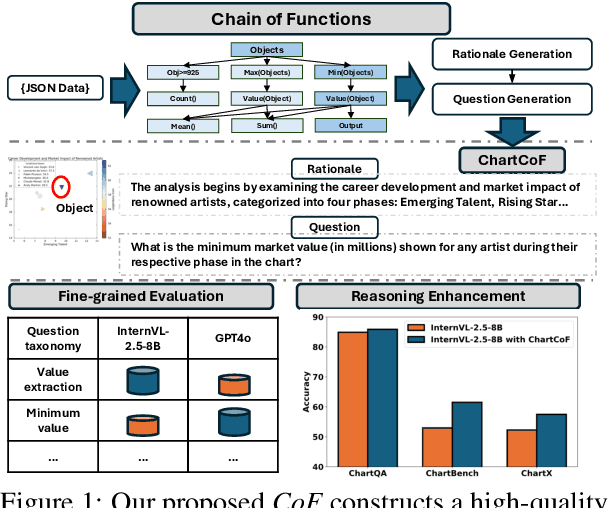

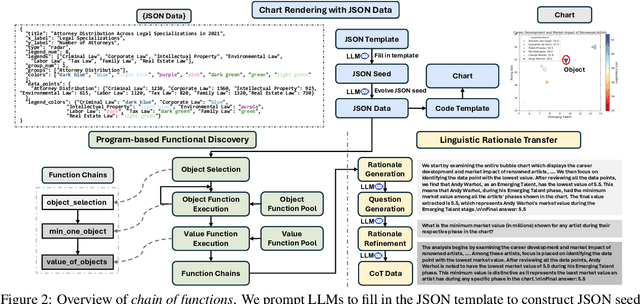
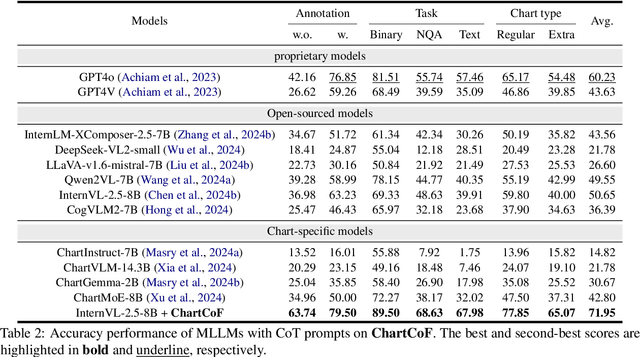
Abstract:Visual reasoning is crucial for multimodal large language models (MLLMs) to address complex chart queries, yet high-quality rationale data remains scarce. Existing methods leveraged (M)LLMs for data generation, but direct prompting often yields limited precision and diversity. In this paper, we propose \textit{Chain of Functions (CoF)}, a novel programmatic reasoning data generation pipeline that utilizes freely-explored reasoning paths as supervision to ensure data precision and diversity. Specifically, it starts with human-free exploration among the atomic functions (e.g., maximum data and arithmetic operations) to generate diverse function chains, which are then translated into linguistic rationales and questions with only a moderate open-sourced LLM. \textit{CoF} provides multiple benefits: 1) Precision: function-governed generation reduces hallucinations compared to freeform generation; 2) Diversity: enumerating function chains enables varied question taxonomies; 3) Explainability: function chains serve as built-in rationales, allowing fine-grained evaluation beyond overall accuracy; 4) Practicality: eliminating reliance on extremely large models. Employing \textit{CoF}, we construct the \textit{ChartCoF} dataset, with 1.4k complex reasoning Q\&A for fine-grained analysis and 50k Q\&A for reasoning enhancement. The fine-grained evaluation on \textit{ChartCoF} reveals varying performance across question taxonomies for each MLLM, and the experiments also show that finetuning with \textit{ChartCoF} achieves state-of-the-art performance among same-scale MLLMs on widely used benchmarks. Furthermore, the novel paradigm of function-governed rationale generation in \textit{CoF} could inspire broader applications beyond charts.
PIKE-RAG: sPecIalized KnowledgE and Rationale Augmented Generation
Jan 20, 2025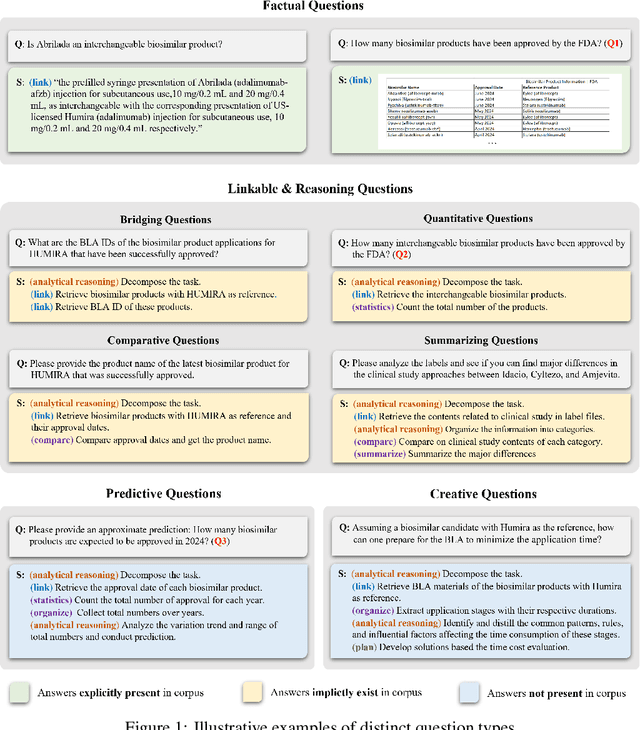
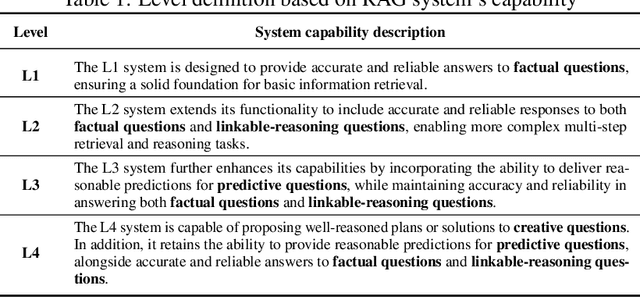
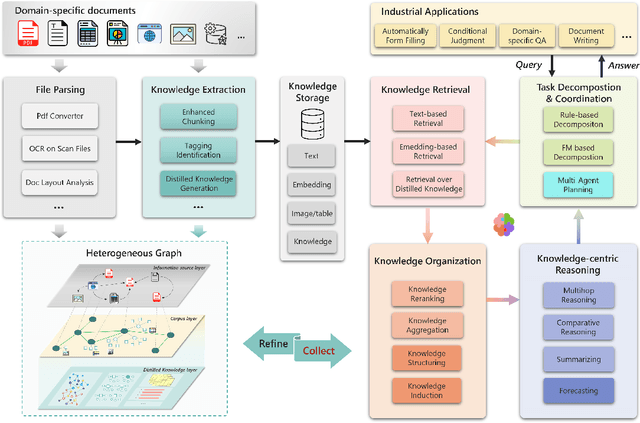
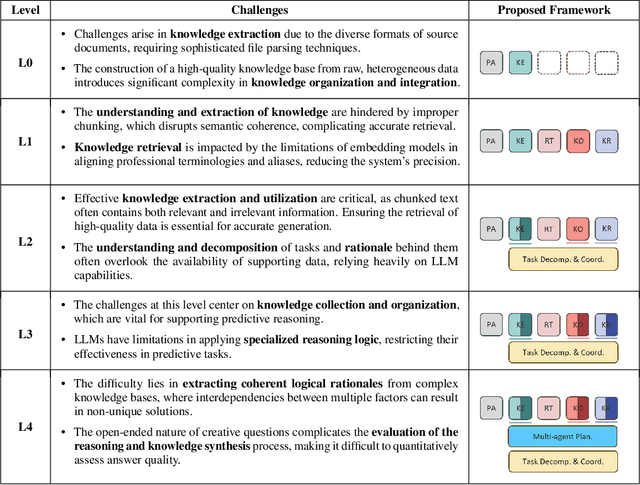
Abstract:Despite notable advancements in Retrieval-Augmented Generation (RAG) systems that expand large language model (LLM) capabilities through external retrieval, these systems often struggle to meet the complex and diverse needs of real-world industrial applications. The reliance on retrieval alone proves insufficient for extracting deep, domain-specific knowledge performing in logical reasoning from specialized corpora. To address this, we introduce sPecIalized KnowledgE and Rationale Augmentation Generation (PIKE-RAG), focusing on extracting, understanding, and applying specialized knowledge, while constructing coherent rationale to incrementally steer LLMs toward accurate responses. Recognizing the diverse challenges of industrial tasks, we introduce a new paradigm that classifies tasks based on their complexity in knowledge extraction and application, allowing for a systematic evaluation of RAG systems' problem-solving capabilities. This strategic approach offers a roadmap for the phased development and enhancement of RAG systems, tailored to meet the evolving demands of industrial applications. Furthermore, we propose knowledge atomizing and knowledge-aware task decomposition to effectively extract multifaceted knowledge from the data chunks and iteratively construct the rationale based on original query and the accumulated knowledge, respectively, showcasing exceptional performance across various benchmarks.
DAS3D: Dual-modality Anomaly Synthesis for 3D Anomaly Detection
Oct 13, 2024



Abstract:Synthesizing anomaly samples has proven to be an effective strategy for self-supervised 2D industrial anomaly detection. However, this approach has been rarely explored in multi-modality anomaly detection, particularly involving 3D and RGB images. In this paper, we propose a novel dual-modality augmentation method for 3D anomaly synthesis, which is simple and capable of mimicking the characteristics of 3D defects. Incorporating with our anomaly synthesis method, we introduce a reconstruction-based discriminative anomaly detection network, in which a dual-modal discriminator is employed to fuse the original and reconstructed embedding of two modalities for anomaly detection. Additionally, we design an augmentation dropout mechanism to enhance the generalizability of the discriminator. Extensive experiments show that our method outperforms the state-of-the-art methods on detection precision and achieves competitive segmentation performance on both MVTec 3D-AD and Eyescandies datasets.
Drantal-NeRF: Diffusion-Based Restoration for Anti-aliasing Neural Radiance Field
Jul 10, 2024Abstract:Aliasing artifacts in renderings produced by Neural Radiance Field (NeRF) is a long-standing but complex issue in the field of 3D implicit representation, which arises from a multitude of intricate causes and was mitigated by designing more advanced but complex scene parameterization methods before. In this paper, we present a Diffusion-based restoration method for anti-aliasing Neural Radiance Field (Drantal-NeRF). We consider the anti-aliasing issue from a low-level restoration perspective by viewing aliasing artifacts as a kind of degradation model added to clean ground truths. By leveraging the powerful prior knowledge encapsulated in diffusion model, we could restore the high-realism anti-aliasing renderings conditioned on aliased low-quality counterparts. We further employ a feature-wrapping operation to ensure multi-view restoration consistency and finetune the VAE decoder to better adapt to the scene-specific data distribution. Our proposed method is easy to implement and agnostic to various NeRF backbones. We conduct extensive experiments on challenging large-scale urban scenes as well as unbounded 360-degree scenes and achieve substantial qualitative and quantitative improvements.
Exploiting Optical Flow Guidance for Transformer-Based Video Inpainting
Jan 24, 2023Abstract:Transformers have been widely used for video processing owing to the multi-head self attention (MHSA) mechanism. However, the MHSA mechanism encounters an intrinsic difficulty for video inpainting, since the features associated with the corrupted regions are degraded and incur inaccurate self attention. This problem, termed query degradation, may be mitigated by first completing optical flows and then using the flows to guide the self attention, which was verified in our previous work - flow-guided transformer (FGT). We further exploit the flow guidance and propose FGT++ to pursue more effective and efficient video inpainting. First, we design a lightweight flow completion network by using local aggregation and edge loss. Second, to address the query degradation, we propose a flow guidance feature integration module, which uses the motion discrepancy to enhance the features, together with a flow-guided feature propagation module that warps the features according to the flows. Third, we decouple the transformer along the temporal and spatial dimensions, where flows are used to select the tokens through a temporally deformable MHSA mechanism, and global tokens are combined with the inner-window local tokens through a dual perspective MHSA mechanism. FGT++ is experimentally evaluated to be outperforming the existing video inpainting networks qualitatively and quantitatively.
Flow-Guided Transformer for Video Inpainting
Aug 14, 2022



Abstract:We propose a flow-guided transformer, which innovatively leverage the motion discrepancy exposed by optical flows to instruct the attention retrieval in transformer for high fidelity video inpainting. More specially, we design a novel flow completion network to complete the corrupted flows by exploiting the relevant flow features in a local temporal window. With the completed flows, we propagate the content across video frames, and adopt the flow-guided transformer to synthesize the rest corrupted regions. We decouple transformers along temporal and spatial dimension, so that we can easily integrate the locally relevant completed flows to instruct spatial attention only. Furthermore, we design a flow-reweight module to precisely control the impact of completed flows on each spatial transformer. For the sake of efficiency, we introduce window partition strategy to both spatial and temporal transformers. Especially in spatial transformer, we design a dual perspective spatial MHSA, which integrates the global tokens to the window-based attention. Extensive experiments demonstrate the effectiveness of the proposed method qualitatively and quantitatively. Codes are available at https://github.com/hitachinsk/FGT.
Feature Selective Networks for Object Detection
Nov 24, 2017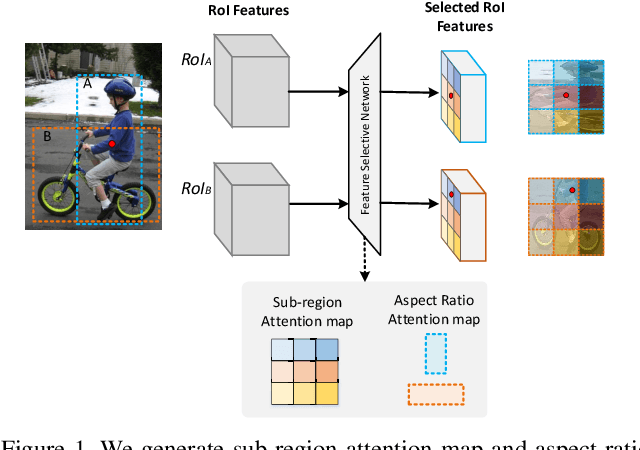
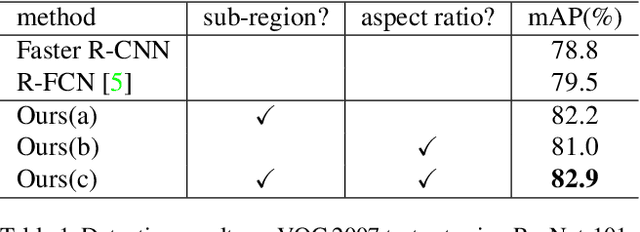
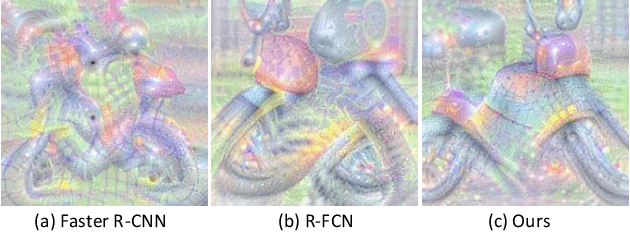
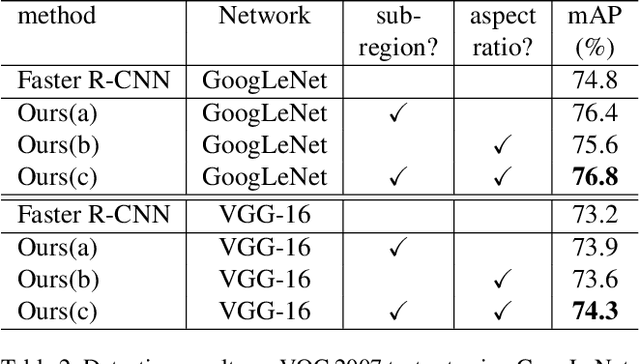
Abstract:Objects for detection usually have distinct characteristics in different sub-regions and different aspect ratios. However, in prevalent two-stage object detection methods, Region-of-Interest (RoI) features are extracted by RoI pooling with little emphasis on these translation-variant feature components. We present feature selective networks to reform the feature representations of RoIs by exploiting their disparities among sub-regions and aspect ratios. Our network produces the sub-region attention bank and aspect ratio attention bank for the whole image. The RoI-based sub-region attention map and aspect ratio attention map are selectively pooled from the banks, and then used to refine the original RoI features for RoI classification. Equipped with a light-weight detection subnetwork, our network gets a consistent boost in detection performance based on general ConvNet backbones (ResNet-101, GoogLeNet and VGG-16). Without bells and whistles, our detectors equipped with ResNet-101 achieve more than 3% mAP improvement compared to counterparts on PASCAL VOC 2007, PASCAL VOC 2012 and MS COCO datasets.
 Add to Chrome
Add to Chrome Add to Firefox
Add to Firefox Add to Edge
Add to Edge